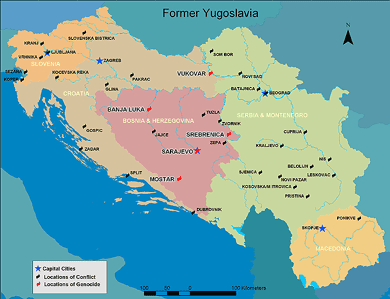Yugoslavia (Former)
In June 1991, Croatia and Slovenia – two of the component republics of the Socialist Federal Republic of Yugoslavia – declared their independence. The secession of the latter was bitterly fought over, both by regular troops and against civilians suddenly resistant to living in ethnically mixed settings. In 1991 and 1992, as Croatia’s military fought Yugoslavia’s military, Croat and Serb civilians in both realms undertook campaigns of “ethnic cleansing” – i.e. efforts by one ethnic, political, or religious group to rid certain geographic areas of another such group through coercion and violence. The dynamics that unfolded in the early 1990s echoed of World War Two-era conflicts in which the Croatian, Nazi-allied Ustashe and Serbian Chetniks fought against one other and targeted their respective opposite’s civilian bases.
After both sides drew back (and Croatia’s independence received recognition), similar dynamics began to unfold in Bosnia and Herzegovina. That republic followed Croatia’s and Slovenia’s leads in declaring independence in March 1992, although Serbian leaders had, by that point, already declared its own independence from the rest of the republic. The ensuing conflict most intensely involved civilian populations in the eastern and western areas of Bosnia, where Serb militias fought to negate Bonsian independence – and, failing that, to eradicate the Bosniak population of those regions. The international response to this campaign was create “Safe Areas” in which Bosniak civilians were to be protected from Serbian militias. The militias, however, targeted the Safe Areas anyway. Most notoriously, a Serbian militia overran the Safe Area of the town of Srebenica, leading the mostly Bosniak civilian population to seek refuge at the United Nations’ base nearby. There, however, forces led by the militia leader Ratko Mladic convinced the UN forces to allow them to separate the men from the women and children. The latter were deported to the zone controlled by Bosniak forces. The former, numbering over 7,000, were massacred. Subsequent jurisprudence, both from the International Criminal Court for Yugoslavia and the International Court of Justice, determined that the massacre constituted genocide.
Later, the remaining Yugoslav republics of Macedonia and Montenegro seceded, as did the former autonomous province of Kosovo. In each case, violence against civilians defined along identity-based lines existed, most intensely so in Kosovo. In 1999, a multilateral force conducted a ten-week-long bombing campaign against Serbian forces, whom Western leaders feared were set to wage another campaign of ethnic cleansing in Kosovo as a response to Kosovo’s independence aspirations.
The Genocide Studies Program has featured numerous seminars relating to the events in the Balkan region. Jasmina Besirevic-Regan, a lecturer and dean of Trumbull College at Yale, sits on the GSP’s board of advisors.
